
Cannon Beach Coast
Self Guided Walking Tour
The Cannon Beach History Center & Museum has identified a variety of historic locations for you to appreciate. Some can be reached on foot, other’s you’ll have to drive to. After all, historically, Cannon Beach was where Arch Cape is now! Here’s a little sneak of peak what to expect you’ll encounter during your self guided historic tour of Cannon Beach, Tolovana, and Arch Cape!

Hotel Bill/Cannon Beach Conference Center (1904)
324 N. Spruce Street
The original Hotel Bill was built by George Bill in 1904, from logs that washed ashore from the experimental cigar-shaped log raft of Simon Benson, who was shipping them to San Francisco. Later purchased by D.A. Osburn, his wife, Edna operated it as the Cannon Beach Hotel. U.S. President Woodrow Wilson signed the register in 1914. In 1943, the U.S. Coast Guard used the 10-room building as a barracks. One year later it was sold to the McNeills who created the Cannon Beach Conference Center.
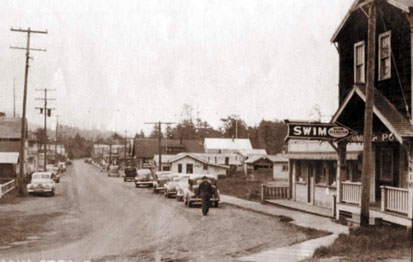
Natatorium (1924)
3rd & Hemlock Streets
Original site of a 30′ x 60′ indoor saltwater pool and bathhouse that served up to 200 guests, providing showers, bathing suits (wool) and entertainment. Motion pictures were shown on the outside wall at night. On the balcony overlooking the pool, there was a “music machine” which provided music for dancing. The owners were Mr. & Mrs. Mahon. To fill the pool, they created a long pipeline to Elk Creek, and during high tide they would pump the water into the pool and chlorinate it, which took about 24 hours. “The Nat” was closed during the war, because of the shortage of oil to heat the water. Before telephones were readily available, the only phone in Cannon Beach was at the pool … it was the old crank type that connected Cannon Beach with the Seaside Operator.

Bruce’s Candy Kitchen (1944)
256 Hemlock Street
This candy store moved from its original location (where Gepetto’s is located) to its newly built home where it still operates today. It was originally operated by Ed & Louise Krusche. Formerly part candy store/part barber shop, the Krusche’s also built six offices upstairs. In 1963, when Treva & Bruce Haskell bought the building, it housed candy and souvenirs. They turned the upstairs offices into an apartment. The building was remodeled in 1985.
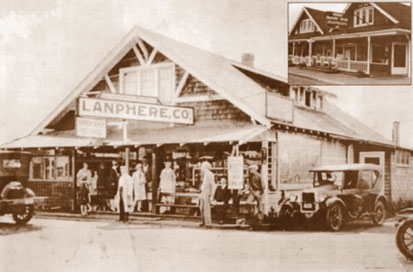
Osburn’s Grocery Site (1915)
248 Hemlock
Osburn’s Grocery operated continuously from 1915 to 2004 when it was sold and the Coaster Village property constructed on the site. In 1942 it housed Dennon’s Dry Goods and the sign had a big Question Mark (“?”) on it … meaning that they had no idea what they did (or didn’t!) have. The adjoining building was then the Cannon Beach Mercantile. In 1974 the Osburns bought the businesses and turned the north side into Osburn’s Grocery and the south side into an ice cream shop (which is still operating on the site today). Today, the space that was Osburn’s Creamery is now Island Grinds Coffee & Juice Bar. They serve coffee, smoothies, juice & light fare, plus…… ice cream!
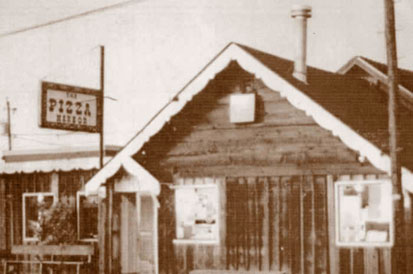
Durk Inn Site (1924)
224 Hemlock Street
The original building, which was razed in 1996, ran under a variety of names since its opening: Durk Inn, Old Time Tavern, Sunset Tavern, Ratskeller, and Grant’s Landing. It was built in 1924 by Thomas Durkin, and, after his death, was run by Mrs. Durkin, who usually wore a fur coat and fancy rings. This was one of the two places in town to buy liquor. It was frequented by many loggers. This site is now part of “The Landing”.
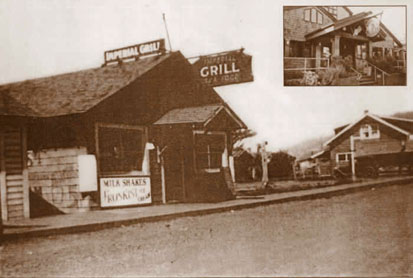
Bill’s Tavern Site (1923)
188 Hemlock Street
A local gathering place throughout the years, Bill’s Tavern was originally started as the Imperial Cafe by William Gallagher. Through many turnovers in owernship, it finally arrived at its current name, Bill’s Tavern. In 1984 Ken Campbell and Jim Oyala bought the building, and in 1997 it was razed to make way for a brand new, larger Bill’s Tavern Microbrewery.
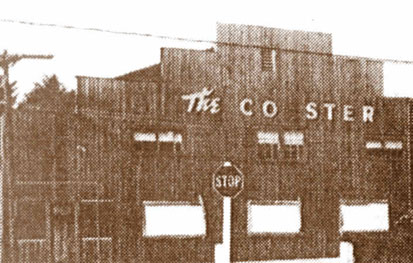
The Wave Roller Rink (1945)
116 Hemlock Street
This building was used as a silent movie theater/roller rink until the 1950s. It was one of the earliest sources of entertainment for visitors to Cannon Beach, who could skate all day for only 35 cents. In those days, in exchange for volunteering to tighten clamp-on skates to customers’ shoes, young boys (“skatesetters”) would be allowed to skate for free. In the mid-1960s, about 55 townspeople began transforming the building back into a theater. In 1972, the building was renovated by Maurie Clark into the Coaster Theater.

The Bowling Alley Site (1945)
115 Hemlock Street
At one time, this building was called Duck Pin Bowling Alley and Penny Arcade. Kids were hired to set the pins back up after customers knocked them down. After World War II, the Bureau of Labor ruled that children were not to work after 6:00 p.m., ruining the business and forcing it to close. In the 1950s, the building burned down.
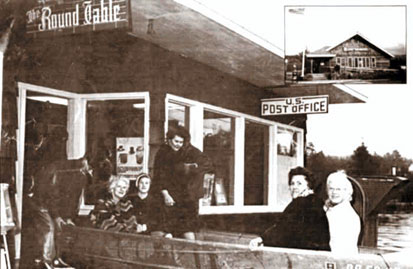
Round Table Restaurant (1925)
163 Hemlock Street
This restaurant had a famous 12-person round table, which became the central gossip loction for the locals. In 1946, the northern part of the building was Joe’s Trading Post, and later became the U.S.Post Office.
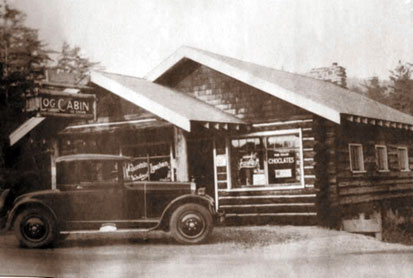
Log Cabin Restaurant Site (1925)
207 Hemlock Street
The Log Cabin was originally built by Paul Bartels for his sister, Marie. Before electical power was available the restaurant used oil lamps to light the tables. Later it was razed and replaced by Morris Fireside Restaurant.
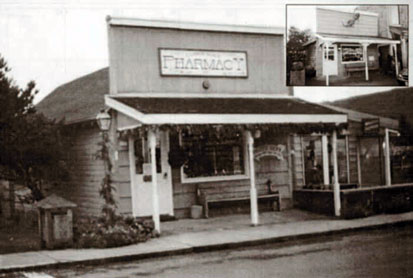
The Cookie Company (1935)
239 Hemlock Street
Originally built by John and Mary Gerritse in 1935 for their daughter-in-law, it has served over the years as a restaurant, Powers Cafe, a liquor store, and a drug store.

The Gerritse Building (1915)
247 Hemlock Street
Built originally by John and Mary Gerritse as a boarding house, the front office of this building became the first Cannon Beach Library. It has also been a butcher shop and a boarding house for loggers. It is said that dances were held on the upper level. Evelyn Georges now owns the building and it is called the White Bird Gallery.
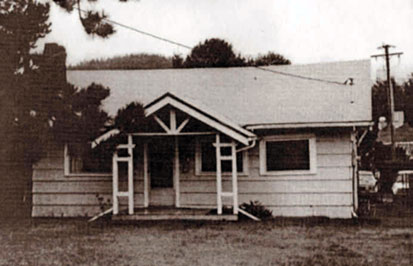
The Graeme Hodgkinson House (1913)
279 Hemlock Street
Originally constructed for Mrs. Galbraith (the aunt of the Hodgkinson family), the building is still used today as a vacation home by the family. The house was built as a “double,” with two front doors … the smaller side to be used as a rental unit and the larger side to house the family.
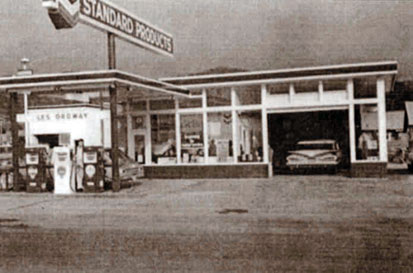
Les Ordway Chevron Station (1933)
295 Hemlock Street
This service station was owned by Standard Oil and Company and operated by Les Ordway most of its duration. Most young men of Cannon Beach worked here at one time or another from the late 1930s until 1979. When Les and his wife first married, they lived in the cottage adjacent to the station.
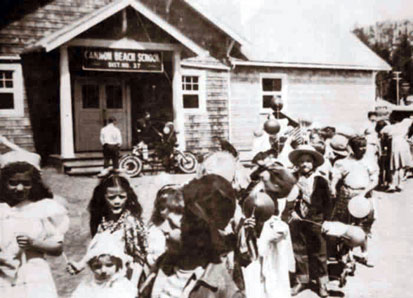
Cannon Beach Elementary School (1922)
Antler Street
In 1912 Ecola (as Cannon Beach was then known) had enough children to establish a school, and the first classes were held in the Hotel Bill. In 1917, the school moved to a rented house, and, in 1921, a one-room school was built in the location of the present school. In 1964 a tsunami left its mark on a swing set still used by children today.
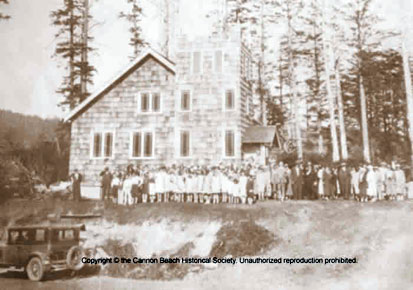
Community Presbyterian Church (1931)
132 E. Washington Street
The church was first envisioned by William Warren and a few others in the community. In1931, Oliver McClaren dedicated the church. Not only was it an important place of worship, but a popular meeting place for members of the community.

William Warren Family Home Site (1911)
3301 S. Hemlock Street
Part of the original homestead of William E. and Emma Sayre Warren, the building was razed in 2001 to construct the present-day Warren House Tavern.
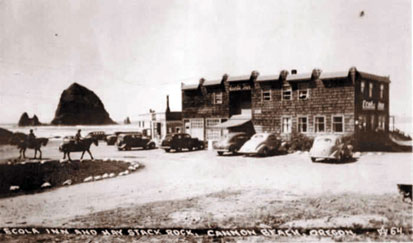
Ecola Inn (1913)
1164 Ecola Court
Built by Roy Becker, a major landholder in Cannon Beach, it was known for its ping-pong tournaments and rude parrot.
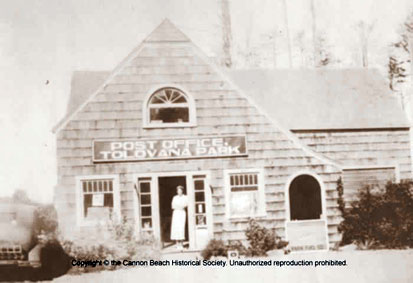
Tolovana Post Office (1922)
3140 S. Hemlock Street
In addition to being the post office, it was the only grocery store south of Cannon Beach, and the gathering place each morning while people picked up their mail. Duncan and Mary Shields started the Park Fuel Company and sold gasoline and oil from a pump in front of the store.
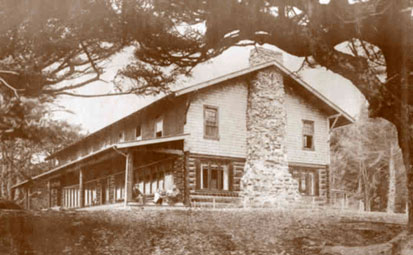
Warren Hotel Site (1911)
3400 S. Hemlock Street
Built by Mark & William Warren, the Warren Hotel was in operation until 1939. Governor Oswald West was the first registered guest. In 1941 it was used as a barracks by the Coast Guard. In the 1960s, it became a popular Christian Center. It was demolished in 1971 to make way for the Tolovana Inn.
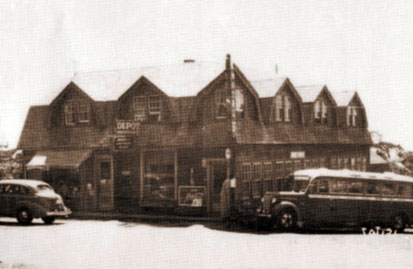
Wavecrest Inn (1920s)
4008 S. Hemlock Street
Built in the 1920s, the Wavecrest Inn, located in the southernmost part of town, was a haven for the wayward traveler. It was a stop for the motor coach, and a gathering place for many people.
